
Modernization
Learn more about government’s intention to modernize the museum to protect our historic holdings and provide better access to our collections.
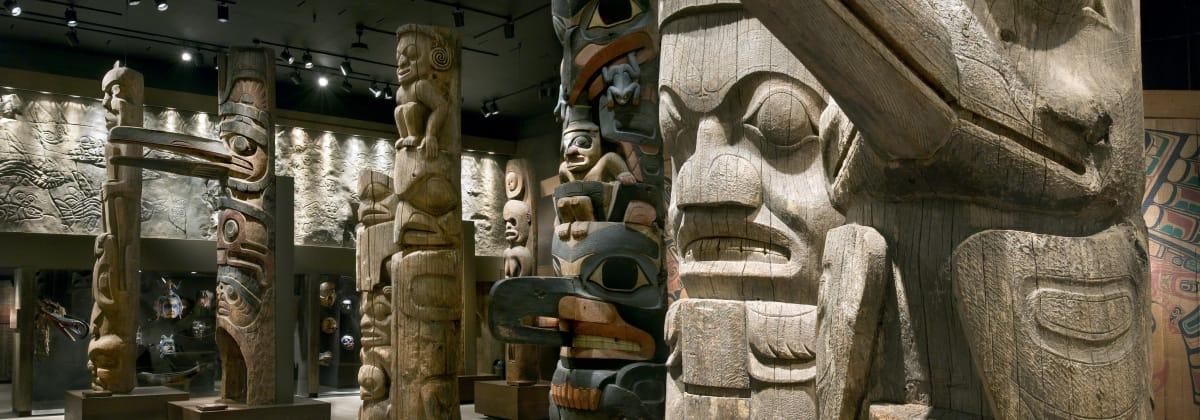

Totem Hall (pictured above) the central exhibit in the First Peoples gallery, features monumental carvings from Kwakwaka’wakw, Heiltsuk, Nuxalk, Gitxsan, Haida and Nuu-chah-nulth communities. Here are crest poles and house posts from Gwa’yasdams on Gilford Island, ‘Qélc (Old Bella Bella) on Campbell Island, Tallheo (Talio) on South Bentinck Arm, Xwamdasbe’ (Nahwitti) on Hope Island, Gitanyow on the Skeena River, hlragilda ‘llnagaay (Skidegate) and t’anuu ‘llnagaay (Tanu) on Haida Gwaii and Numnuquamis on the Sarita River in Barkley Sound. The juxtaposition of these magnificent carvings emphasizes the variety of different pole types and carving styles, and evokes the grandeur of 19th-century coastal villages.
Around the perimeter of the hall are examples of masks, regalia and modern works by Kwakwaka’wakw, Heiltsuk, Nuxalk, Haida, Tsimshian, Gitxsan, Nisga’a, Nuu-chah-nulth and Salish master carvers. In contrast to the previous exhibits of arts and artifacts in the context of traditional technologies and ways of life (on the mezzanine floor) and post-contact histories of First Nations (in the sequence of galleries surrounding Totem Hall), these works are presented as art.
When the First Peoples gallery opened in 1977, First Nations works were usually classed as anthropological artifacts or examples of material culture rather than as art. Although First Nations languages do not have words for art in the sense of works intended only for decoration and contemplation, this exhibit uses the term in recognition of the exceptional aesthetic qualities and superb workmanship of Northwest Coast carving of the past and today. The display unites old and new works, which is appropriate in an exhibit that emphasizes the continuing artistic traditions of the Northwest Coast First Nations.
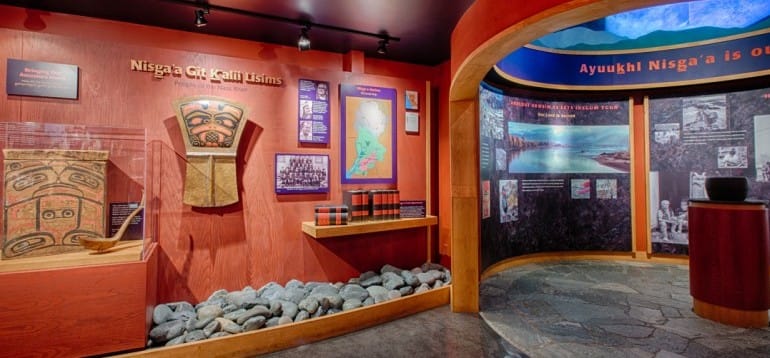
The Nisga’a Final Agreement (the Nisga’a Treaty) was the first modern treaty in BC. Its ratification in 2000 was a significant event in the recent history of the Province. Nisga’a: People of the Nass River, focuses on what the Nisga’a Treaty means to contemporary Nisga’a society. The exhibition was a joint project of the Royal BC Museum and the Nisga’a Lisims Government in 2002.
The Nisga’a Treaty was the culmination of centuries of consistent work by the Nisga’a people. The long struggle for legal title to Nisga’a ancestral lands and the right to self-government and control over their own lives is an exhibition theme. An historical timeline is part of the extensive background information that visitors can access on the computer monitor in the exhibition. Cultural values are stressed as much as history in this installation, though. Sharing and co-existence are fundamental Nisga’a social and legal principles; the exhibition reveals that these principles are integral to the Treaty’s importance to the Nisga’a Nation as well. Ayuukhl Nisga’a (the ancient code of laws and customs), Hańii-see-sit’aama’a (a new beginning) and some of the areas of jurisdiction of the Nisga’a Lisims Government that were secured by the Treaty such as Gansiwilaaks (education), Ts’im galts’ipts’ap (community), Lax ts’eets’iksguḿ (environment), Gandi’akhla’amskw (resources) and Lip wilaa looḿ (culture) are at the heart of the installation. Through contemporary images of people and the land, cultural objects and quotes from Nisga’a citizens, the exhibit gives expression to the modern, vibrant, living culture of the Nisga’a people.
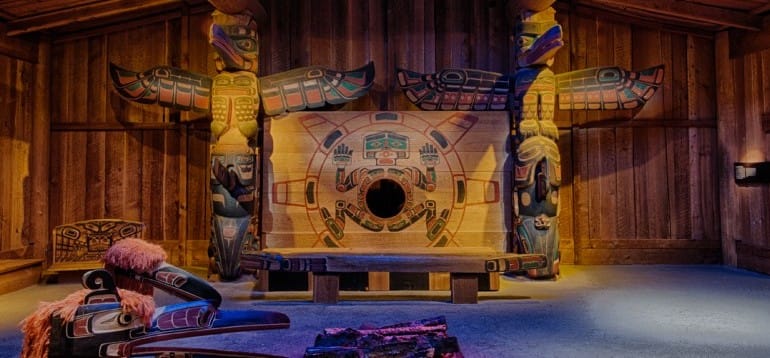
In the First Peoples Gallery in the Royal British Columbia Museum, you are privileged to enter the house of Chief Kwakwabalasami, the late Jonathan Hunt, a Kwakwaka‘wakw chief who was born and lived his life in the community of Tsaxis (Fort Rupert) on the northeast coast of Vancouver Island. The house is both a museum installation and a real ceremonial house. In the potlatch system, the Chief formally presents, to an invited audience, crest images, songs, names, and other prerogatives to which he claims inherited rights. The audience’s recognition of the Chief’s claim is its legal validation. Jonathan Hunt potlatched twice for this house, once at Victoria and once at Alert Bay, and spent thousands of dollars in the appropriate manner to confirm his right to display the house and its images. An arrangement between Jonathan Hunt, his descendants and the Royal BC Museum allows the Museum to exhibit the house permanently, while cultural ownership of the house and its images remains in the Hunt family.
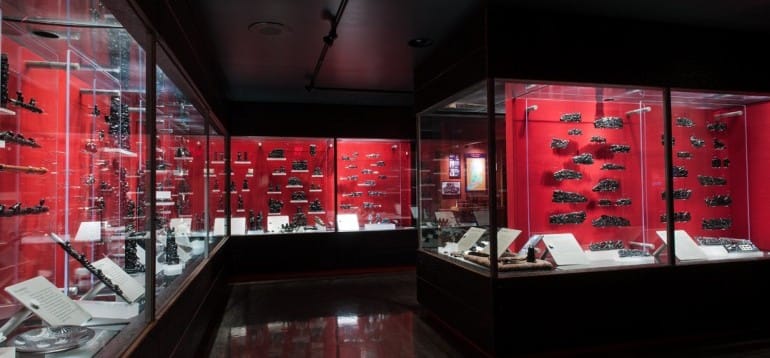
Argillite, a black shale, is obtained from a quarry on Slatechuck Creek near Skidegate on Haida Gwaii. The Haida began to make commercial carvings from this stone in the first quarter of the 19th century. Archaeological evidence suggests that argillite pipes may have been used ceremonially in early times but historical argillite carving is an export product – the first “tourist art” of the Northwest Coast. Although the concept of a discrete category of non-functional, decorative objects may not be indigenous, trade and fine carving have always been important to the Haida economy and argillite carving was from the beginning a sophisticated, refined art form. As a tourist art, argillite carving challenges conventional ideas about curio production and traditional art.
The Haida Argillite Carving gallery at the Royal BC Museum traces the history of one of the most significant artistic traditions of BC. Over 150 argillite objects are on view, the majority donated to the Royal BC Museum in 1978 by Francis and Kay Reif of Vancouver. The Reif Collection of argillite carvings is one of the most complete ever assembled, with examples of every type, period and subject of the historical art form. In some of the carvings, creatures from the Haida spiritual world express the powerful relationships and porous borders between the natural and supernatural realms. Other carvings reflect the presence of European and American traders and settlers in Haida Gwaii and the changes that occurred in Haida culture during the historical period of commerce and colonization. Examples are panel pipes carved between 1830 and 1850 with creatures from the Haida cosmos, representations of Europeans carved between 1840 and 1860, and model totem poles and platters carved between 1885 and 1920. The exhibition concludes with art works by Robert Davidson, Reg Davidson, Chris Wilson, Ron Wilson and other contemporary master carvers. The only non-argillite work in the exhibition, an exquisite gold box made by Bill Reid in 1971, testifies to the influence of the argillite carving tradition on modern Haida art.
Visitors can find more information about the history of argillite carving and descriptions of the works in the Royal BC Museum’s publication, The Magic Leaves: A History of Haida Argillite Carving, an electronic version of which is in the exhibition.
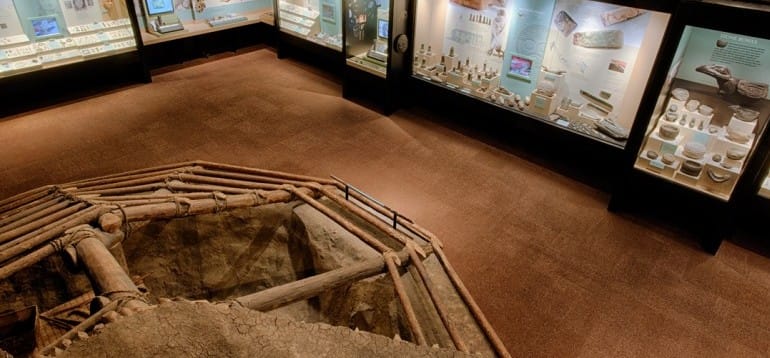
First Peoples have lived in this region for thousands of years. Early on, they learned how to use what the land offered them and to adapt to changing resources. They crafted a variety of useful and decorative items from wood, stone, bone, antler and other materials.
These people left behind some of the tools, weapons, and other items they made. Today, we find these items underground where they have been covered for hundreds or thousands of years by the very land they came from.
This display shows a selection of ancient artifacts found in British Columbia. It reveals the great skill of the people who made them and the new technologies they developed through time.
For more than 3,000 years, some of the aboriginal peoples of British Columbia’s southern interior used pit houses for their winter homes. This model is a smaller example of a pit house. Most were 8 to 10 metres (26–33 ft) in diameter and 1.5 metres (5 ft) deep – a large pit house could be 20 metres across and accommodate up to 30 people.
Well insulated by an earth-covered roof and a layer of snow, a pit house needed only a small fire to warm its interior. People went in and out via a notched pole ladder extending through the smoke hole in the roof. Most pit houses had a side hatch as an emergency exit and for bringing in firewood.
Kekuli is the word for pit house in the language of the Secwepemc people of south-central British Columbia. The construction of this house model was based on historical drawings, photographs and information from Secwepemc advisor Ike Willard, who was born in a kekuli.
Proud sponsor of the First Peoples gallery re-scripting project
